Noticing what was in the woods
I have always been interested in nature as a subject for my artwork, and for many years I drew on it in a sort of abstract and generic way, working from drawings and imagination. I framed my stitched paper artwork, or I made it into bookmarks and the covers of handbound journals, which I sold at gifts shops, galleries and art fairs. I repeated designs once I had mastered them, focusing on variations of my favorite ones as well as the ones my customers preferred.
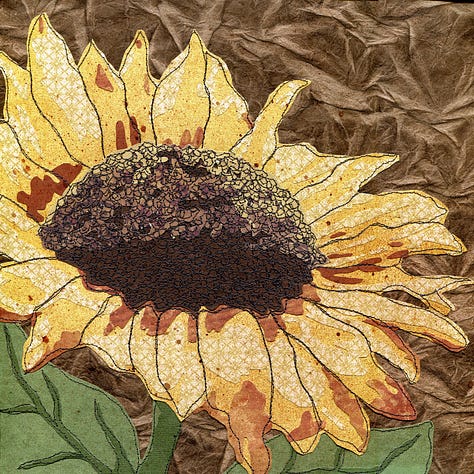


I also used to take daily walks through my little forested neighborhood, around the lake following the road through the woods. These walks started out as pure exercise, a lap around our gravel lake road, a way to get out in the sunshine on warm days or just to get the body moving. Where they’ve ended up I could not have predicted. In a sense, I’ve taught myself a new way of looking at my world and have learned to claim and inhabit the place where I live in a new way.
I used to walk quickly in order to bring up the heart rate and, except when I was watching where my feet landed on the gravel, only looked up. There’s plenty of beauty up there. But I didn’t know what I was missing.
In February of 2017, I noticed an interesting seed pod cracking open, with a few fuzzy seeds hanging, ready to fly. Perhaps I noticed it because it was about head height. Perhaps there was movement in the wind. For the first time, I craved the name of something. I took out my cell phone, snapped a picture and did an online search. This was before good image searching, before I had even heard of plant ID apps. I did not have any luck finding out that seed pod’s name, not then, but my walks around the lake changed.
I began to notice all kinds of things. As winter gave way to spring, I examined wildflowers growing on the edge of the road. Mushrooms sprouting from the many fallen logs within a few feet of the gravel. And bugs! So many intricate and beautiful bugs I had never bothered to notice before. And I kept watching that plant with the interesting seed pods.
By summer, several new plants were growing in the spot where I had found those winter seeds. Then tiny flowers bloomed.
But it wasn’t until late summer, when there were suddenly dozens and dozens of hairy orange and black caterpillars stripping the plant bare, that I got the name I had craved. The caterpillars were Milkweed Tussock moths (Euchaetes egle) and one of the only plants they lived on was Hemp Dogbane (Apocynum cannabinum). I had my identification. And a new purpose.
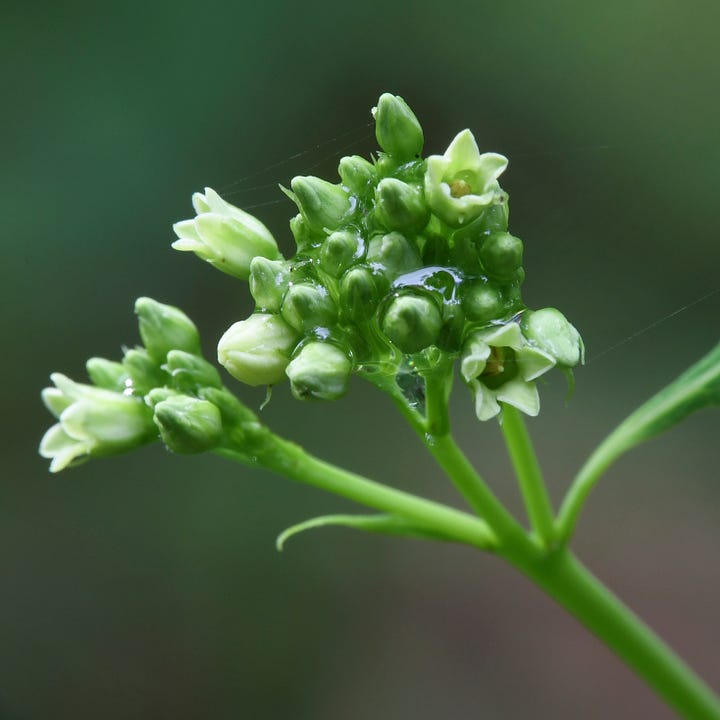

I dug out my digital SLR camera and its lenses. I brushed up on my photography and read about macro photography in earnest. I carried the camera on every single walk through the woods. I added more field guides to my collection and got more comfortable using them. I got better and better at knowing which keywords to use in online searches. My walks become shorter in distance, but longer in time.
The walks changed again. First I strayed from the road onto the few ATV trails through my neighborhood woods. Away from the road, in the full shade of the forest, things were different. Quieter, with a quality of light only available filtered through the trees. I was less than a mile from home but could have been lost deep in an unknown place. Because I didn’t know these woods. I’d lived here 10 years but had never gotten to know it at all. But now I was learning.
There’s a creek that runs through a gully on the property, which starts at a waterfall I knew was there but had never seen. I started straying from the ATV trails and following the creek bed. I got wet feet, bramble scratches and bug bites. I also got to see my first Jack-in-the-pulpit flower, my first Devil’s Urn mushroom, my first Green Frog. One day I knelt right down in the leaf litter to look closely at a patch of moss, noticed the sporophytes and have had permanent mud stains on most of my jeans ever since. I really do lie on the ground to get close to the tiny things. I met a salamander that way.
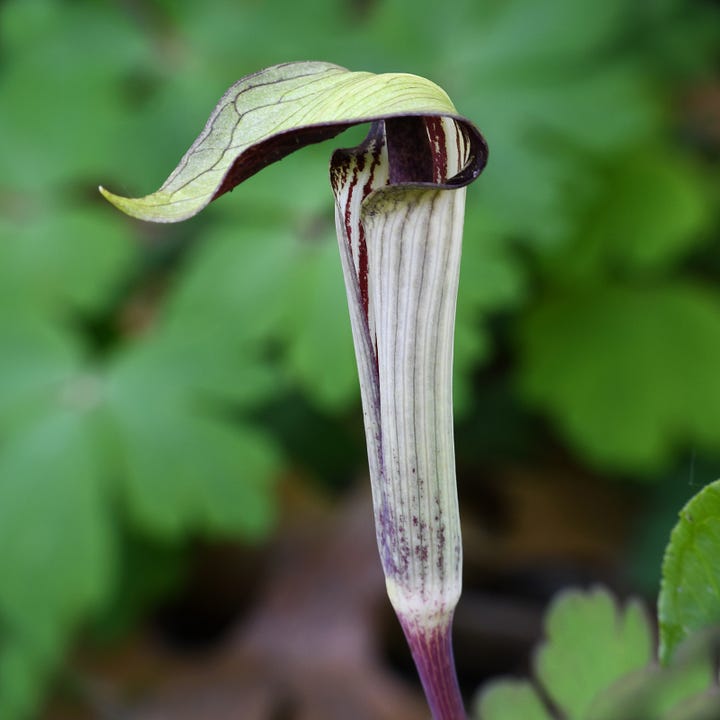
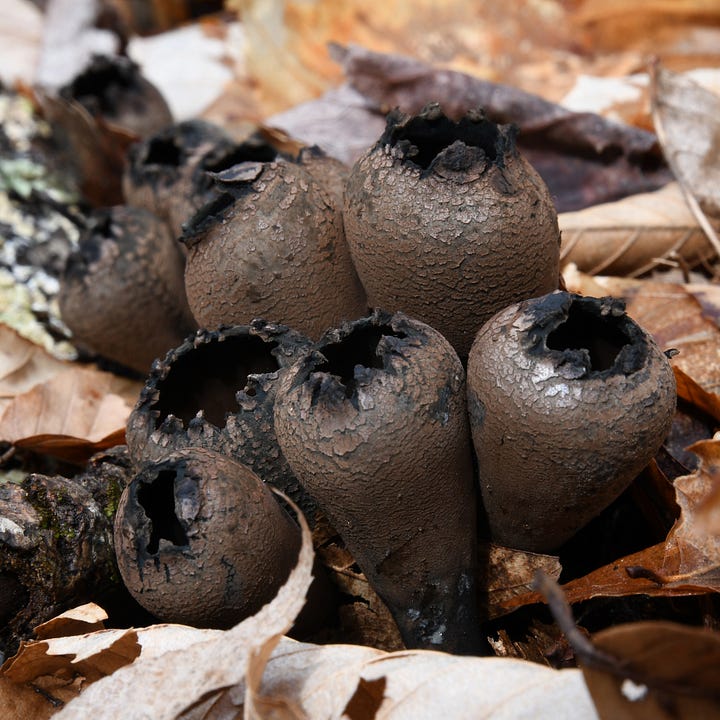
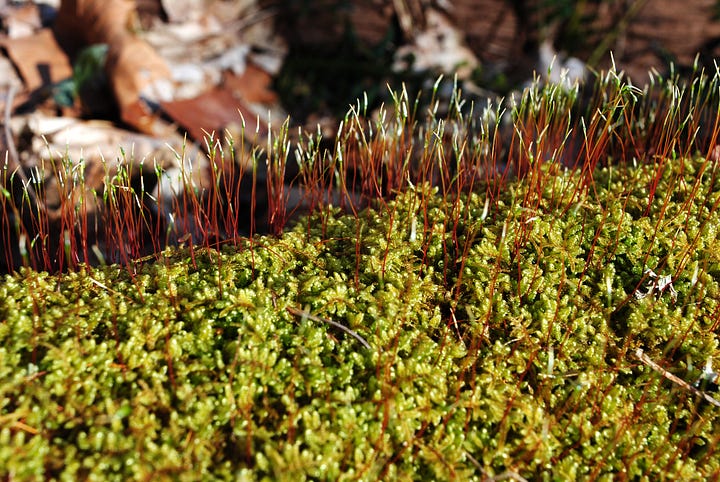
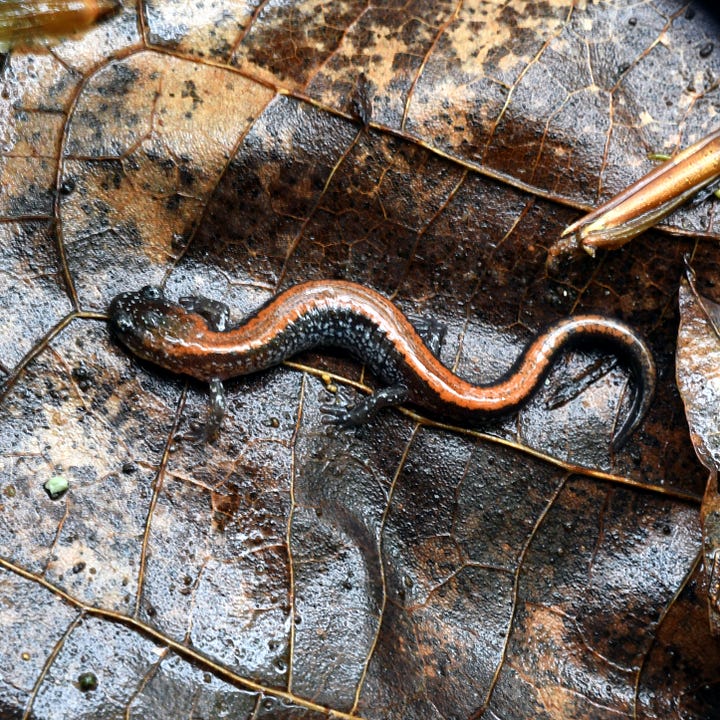
Naming what was in the woods
I used to walk and sometimes saw things. Now I was walking in order to look and I always saw things. I walked very slowly. I stopped often to stand perfectly still, look around me and listen. I investigated every odd splash of color, every shape that seemed slightly out of place, every movement out of the corner of my eye. Often it was nothing – just a leaf or rock or even a piece of trash discarded by someone long before me – but often enough, it was something worth seeing. I looked closely, took a photograph and went home to look up a name. With practice, a growing vocabulary of mosses, mushrooms and wild plants, and help from the many nature-based Facebook groups I’ve joined, identifications got easier. I’ve gathered the names of hundreds of things.
I started curating photographs from my daily walks and posting them on my Facebook page, with nature facts and observations and any IDs I could make. People responded. I posted nearly every day.
While my artwork didn’t change significantly yet, I was starting to incorporate my daily woods walks into an overall artistic practice. As a poet and visual artist, I’d always journaled, but the way I worked in my journals evolved. I printed my photos and pasted them into my journals, where I also wrote about my walks, mused about ideas, and reflected on my reading, which began to take a serious turn toward the world of nature.
Understanding what was in the woods
I now walk through the woods and greet things by name, sometimes saying the names out loud, which helps me to remember them over the long term, but also makes me feel more and more a part of this forest community. I’ve watched several cycles of spring blooming, summer ripening, autumn turning and winter pulling back. I know specific spots where I can see Wild Geraniums, or Wood Phlox, or Hazelnut trees. I know on which part of the creek bed the Prairie Trilliums will flower, where to look for Bird’s Nest fungi and where there might be frost flowers if the conditions are just right. I know when the lichen forms fruiting bodies and that Sassafras trees form berries and when they’ll turn blue.
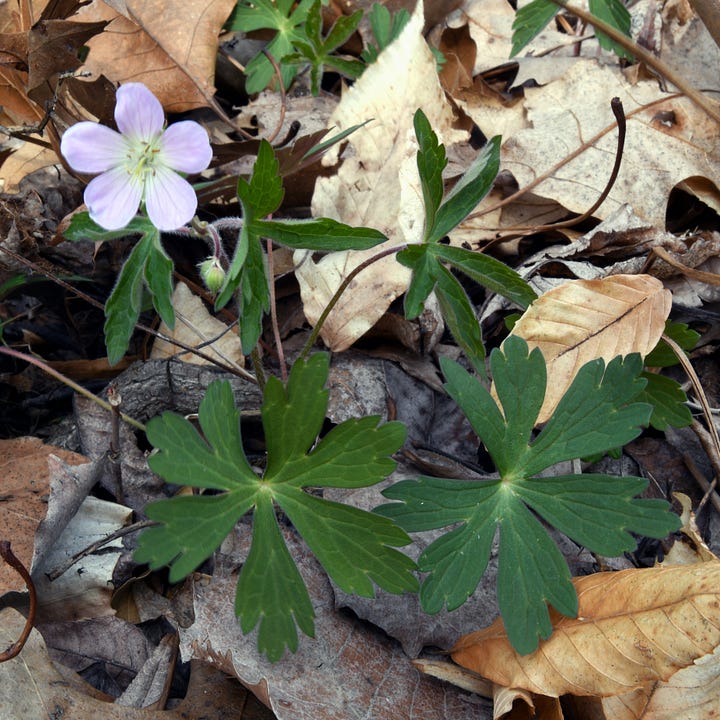
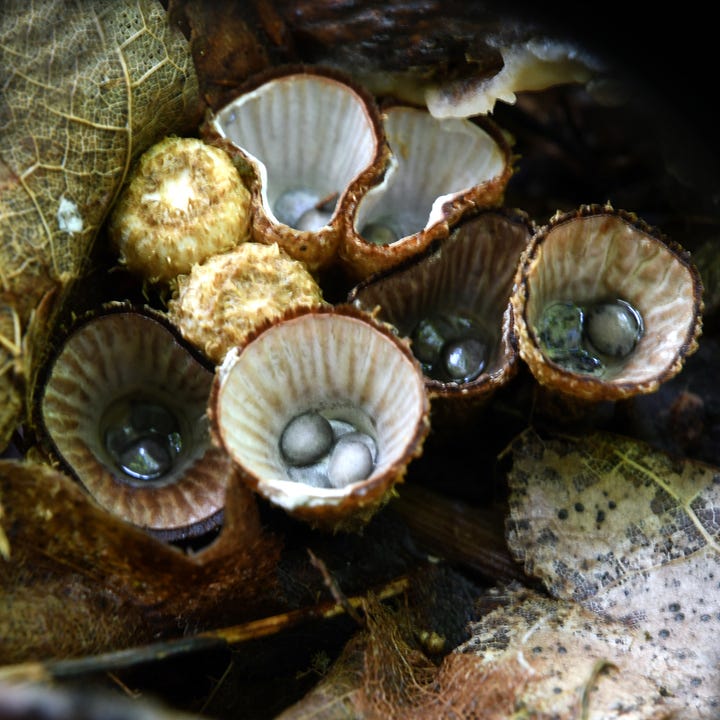
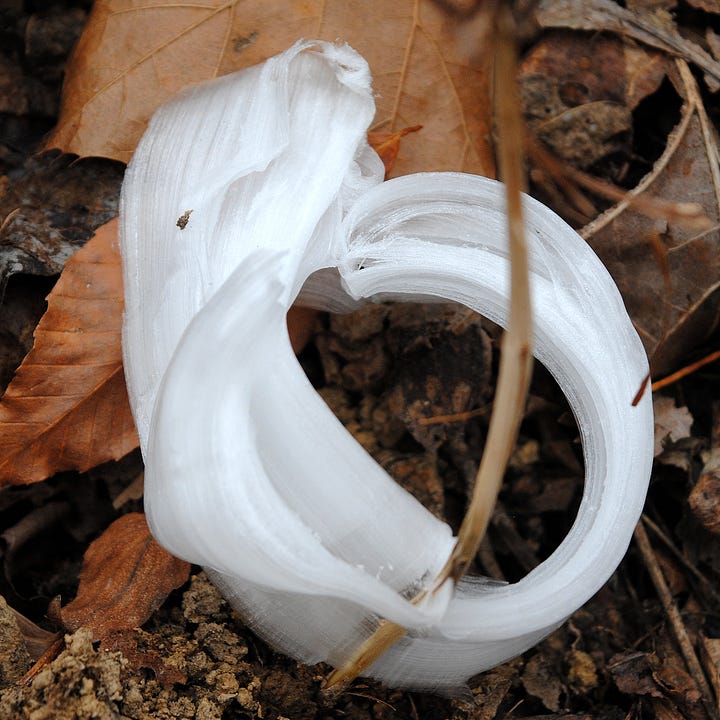
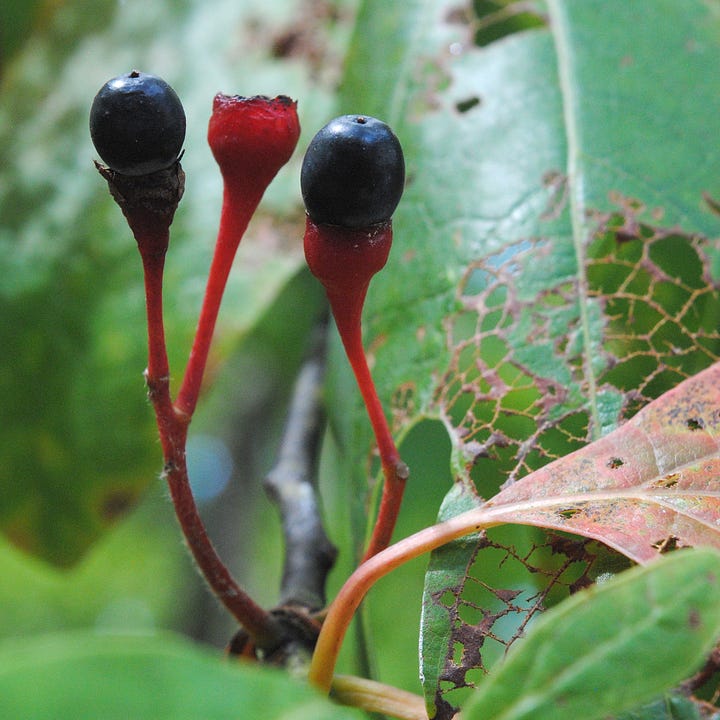
I’m learning patience. Once, after startling an Eastern Box Turtle, I sat as still as possible on a rock for more than 15 minutes waiting for him to come back out of his shell. It was worth it when he looked at me with his red eye.
I joined a hiking group with like-minded people who stop and look and name things as well. My heart swells just thinking about it.
Not surprisingly, the way I made artwork also changed. My stitched paper artwork contained more wildflowers and native plants. I had more photographs from which to make patterns. I’ve made bug artwork and mushroom artwork and artwork about moss. I still sold at art fairs and gift shops, but I also began to enter my pieces into juried gallery exhibitions as well.
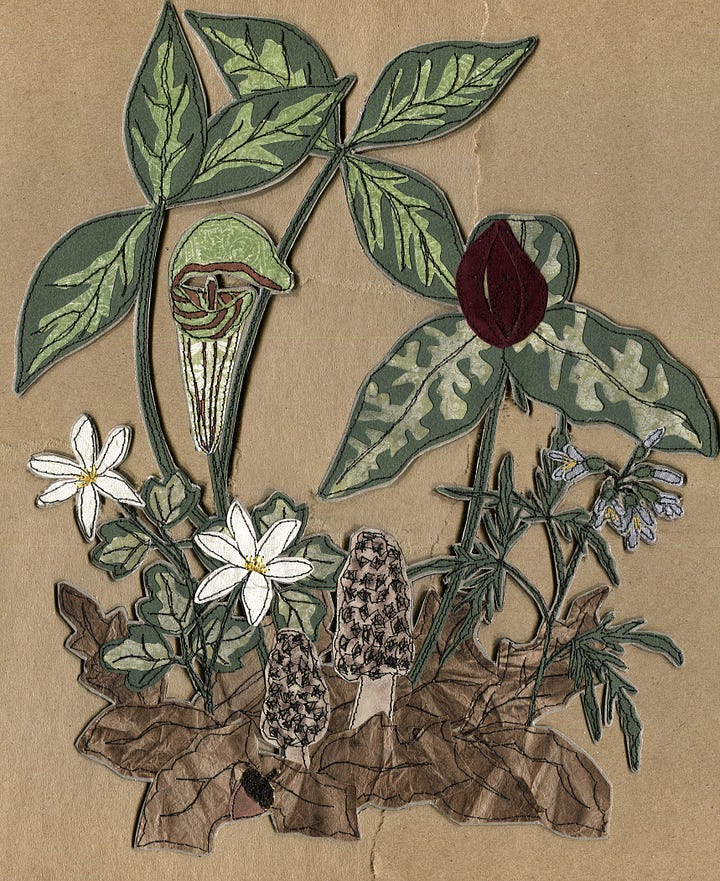
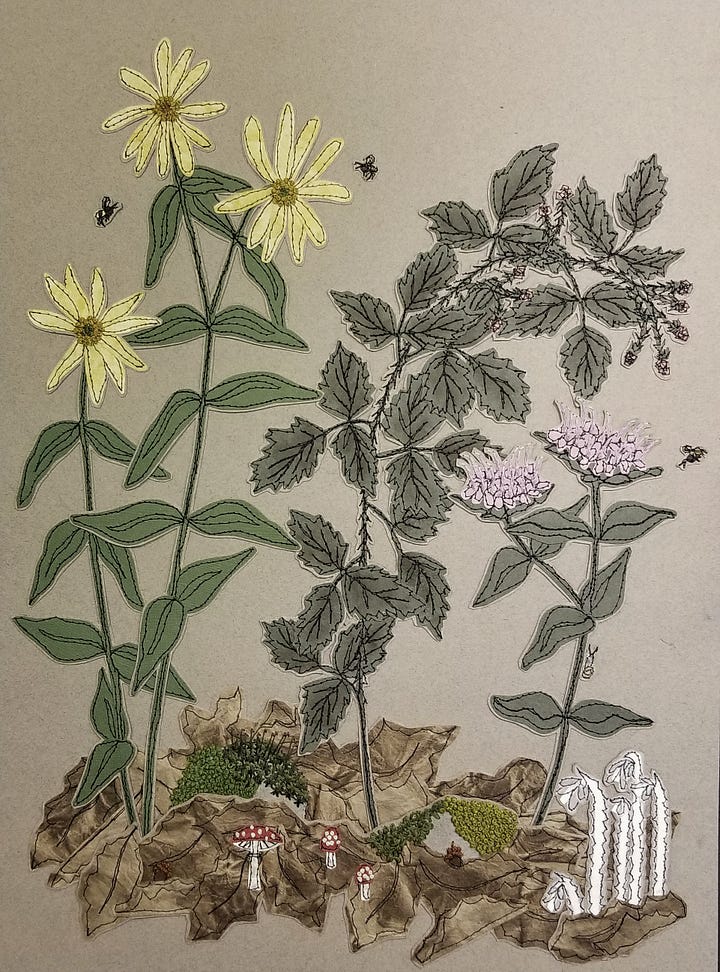
I started writing poetry daily again, to try and capture what I was seeing, yes, but also what I was feeling, which is the greatest sense of wholeness, wonder and contentment I’ve ever found. I published two books filled with my poetry and photography. I learned things about myself. The woods is my place. I love the astounding variety of mushrooms in the world, the alien strangeness of slime molds, the harsh cries of blue jays.
Losing the woods
A couple years later, things began to change. I developed Scleroderma, a chronic illness that made it difficult to hike in the woods. My hikes became shorter and shorter, until I could only make it far enough to walk my favorite creek bed on rare occasions when I felt good enough. I’ve written in detail here about my journey through illness with artwork. But, I never entirely let go of walking in the woods as part of my artistic practice. My husband built me a bench in the woods behind our house for when I didn’t feel up to walking. Here I could sit in the woods, journal and do watercolors, watch and listen.
I wasn’t taking as many photos in the woods, because I wasn’t there as often. But I had thousands of photos I’d taken over the past few years, and I began to look at them in a new light. I am especially enamored with mosses with and their wide range of textures and intense greens, even in the depths of winter. They are early colonizers of the bare and disturbed areas, ancient non-flowering plants that enrich the atmosphere with oxygen and pave the way for more complex life. I had photographed them often. I tried hand embroidery directly into my moss photos to highlight their textures and colors, their intricate beauty.
I walked in the woods when I could, sometimes just dipping a bit into the trees on the edge of my yard to look for mushrooms on fallen logs. Sometimes I still made it out onto my favorite trails, and I treasured the time I spent there, and felt more urgency to document what I saw there, since I felt I was losing the woods.
Remembering the woods
I was also forced to experiment in the studio, to learn what was possible within my limitations. I discovered that a return to hand quilting and the embroidery I did as a child, plus machine quilting on a smaller scale, all made continued work possible. I began to gel print on papers and fabrics and learned to eco-dye fabrics and papers using leaves from my woods. Out of these discoveries, new forms of artwork emerged, exploring a real sense of the place where I live and work, my new relationship to it, and my sense of loss and the experience of relearning and rediscovery.
Against Forgetting What Has Been Lost was a direct result of this rediscovery. Made from fabrics eco-dyed using leaves from the woods, the piece combines hand quilting with hand embroidery in 3 dimensions to embody my memories of the mushrooms, moss and lichen that I loved to find on those walks.
It is a souvenir of my life before Scleroderma, a reminder to myself that what has been lost to me is still alive in the world, and a love song to the forest floor.
Re-creating the woods
I couldn’t walk in the woods as much as I wanted to anymore. I asked myself: If I can’t go into the forest, what would it mean to bring the forest into the studio and gallery? Forest Reliquaries are a literal re-framing of nature, a recontextualization into man-made vessels. Think terrariums. Think museum specimens.
I'd been collecting antique boxes, canning jars, bell jars, old books, damaged frames, and objects found in the woods. From my years of woods-walking I had photographed thousands of tiny natural things. Now I used everything I knew – machine quilting, hand embroidery, beading, and paper and fabric sculpture techniques – to re-create tiny bits of the forest in my studio. Collected and displayed together, they comprise a cabinet of curiosities honoring my love of the forest floor.
Incorporating the woods
I cannot hike the way I used to, but I can still spend time in the woods looking, sketching and gathering. Since my time there has been so curtailed, I feel a growing desire to create physical souvenirs of time spent in the forest. During the downtime of Covid, I took online classes exploring eco-dyeing with leaves from the woods and basketmaking techniques using natural materials. These allowed me to use even short woods walks for foraging for my artwork. (I’ve written extensively here about how this particular kind of making helped me find a way through illness and grief).
When I foraged invasive Bittersweet vines from my woods and combined them with my new paper quilts, everything opened up again. This new work is both “about” and “of” the woods.
In autumn 2024, I was the Artist in Residence at Bernheim Forest and Arboretum. I spent my seven weeks there gathering leaves from trees in the arboretum, eco-printing on cotton rag paper with the leaves, foraging invasive vines from the forest and making frameworks from them, and beginning to create an artwork that will be installed at Bernheim sometime in the summer of 2025.
I spent time sitting among the trees, journaling and photographing, and incorporating parts of the trees and woods into a new kind of artwork. The final piece will be a commentary on how spending time around trees can actually improve our health, decreasing anxiety and blood pressure, lifting mood, and strengthening our immune systems.
Incorporating the woods into my work has resulted in a changed but deepened relationship with particular places. I don’t walk in the woods as often as before, but I think I get more out of each experience.
Collaborating with the woods
Where will my journeys in the woods take me next? I’m starting to explore diving even deeper into the idea of place, collaborating directly with the woods in several ways. I’ve made some homemade inks from Sweetgum tree seed balls and from Shellbark Hickory nut husks.
My artist friend Rachel Kavathe is teaching me how to make my own pigments from stones I collected from the creek bed in the woods behind my house.
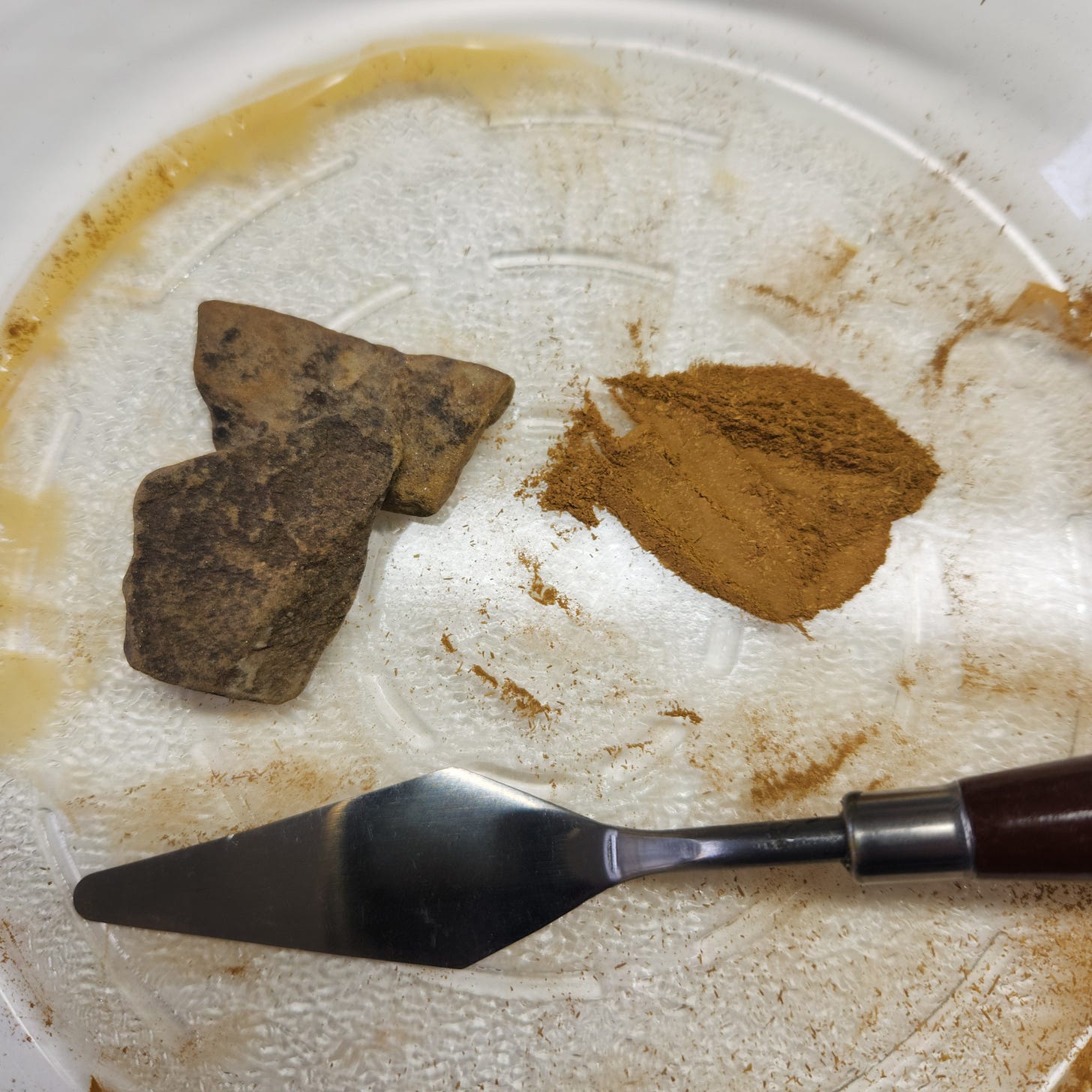
And I’ll be taking a workshop this summer from a local artist who is an expert in natural dyeing. I’ve gathered acorns from my woods that will be used to dye cotton fabric. I hope to eventually dye my own embroidery floss using plants and lichen from my woods, and to make paints from leftover dye baths to use on fabric and paper.
Every step on this journey deepens my relationship with the woods. Even on short walks now, I’m always looking: at the plants, the mushrooms, the mosses, and now the rocks and earth itself as well. I’m photographing the woods, I’m sketching the woods. I’m gathering leaves for eco-printing, and stones for pigment making, and acorn caps for dyeing. I’m considering what I might sustainably forage to incorporate into my artwork, and how I might use the invasive species I’m removing.
I’ve even made some artwork and installed it in the woods, to see what will happen as the work collaborates with the weather, the plants, and all the creatures that live there.
Anyone can do what I did, though your journey will be entirely your own. Go outside, wherever you live, and look. Follow that trail or walking path. Examine one area of your yard, your local park, or those trees planted on Main street (I bet they have lichen on their trunks!). Watch a single plant as it sprouts, grows, blooms and makes seeds throughout the year. Then photograph or draw or paint or write down your thoughts about what you see. Buy a field guide or join a Facebook group, if you too want to know the names of the new things you’ll meet.
Just by looking closely, the world I inhabit has expanded, like a magic trick. The physical boundaries of it haven’t grown an inch, but what it contains continues to multiply and multiply. I’ve no idea where my woods walking journey will take me next.
To see more of my work, you can visit my website.



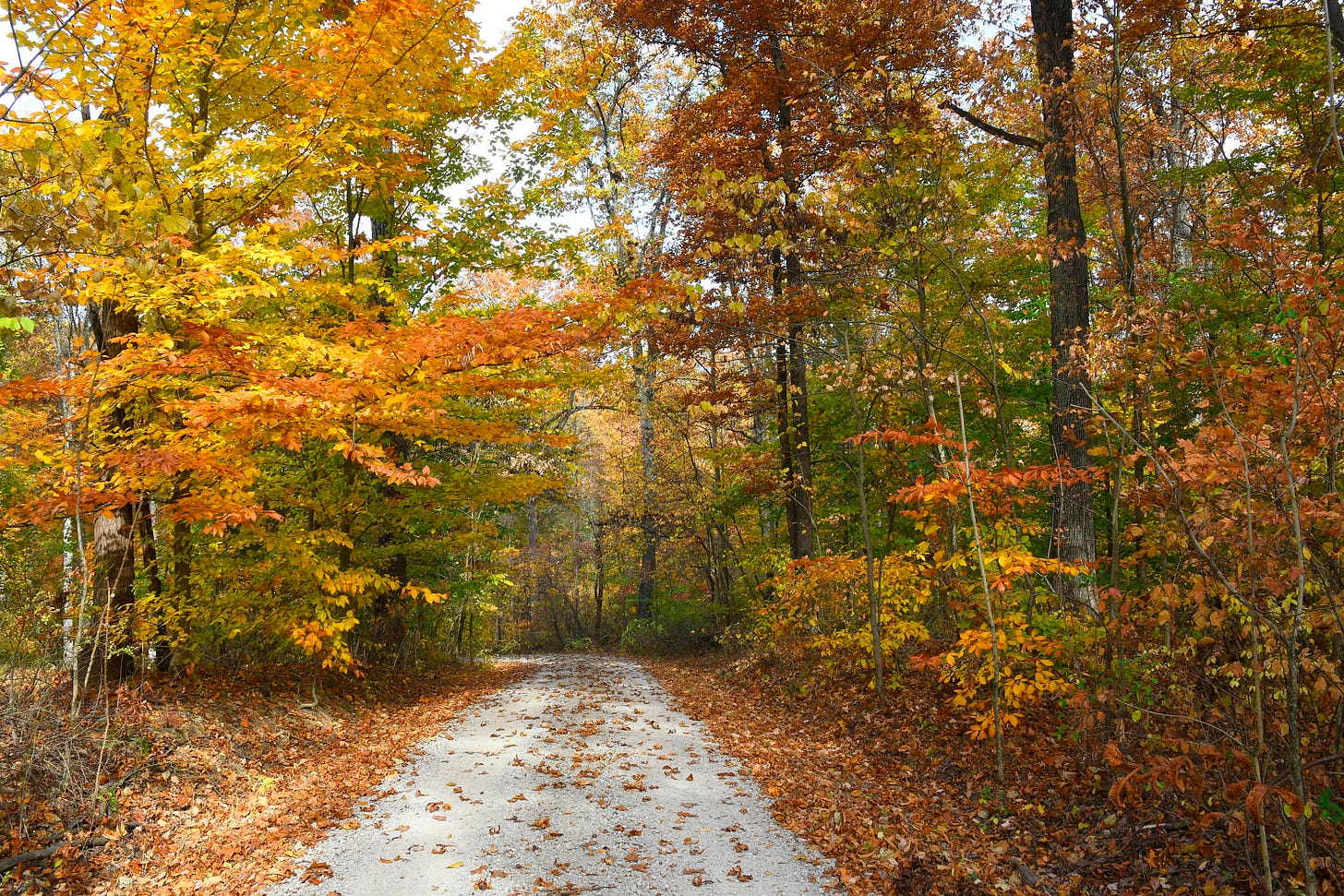
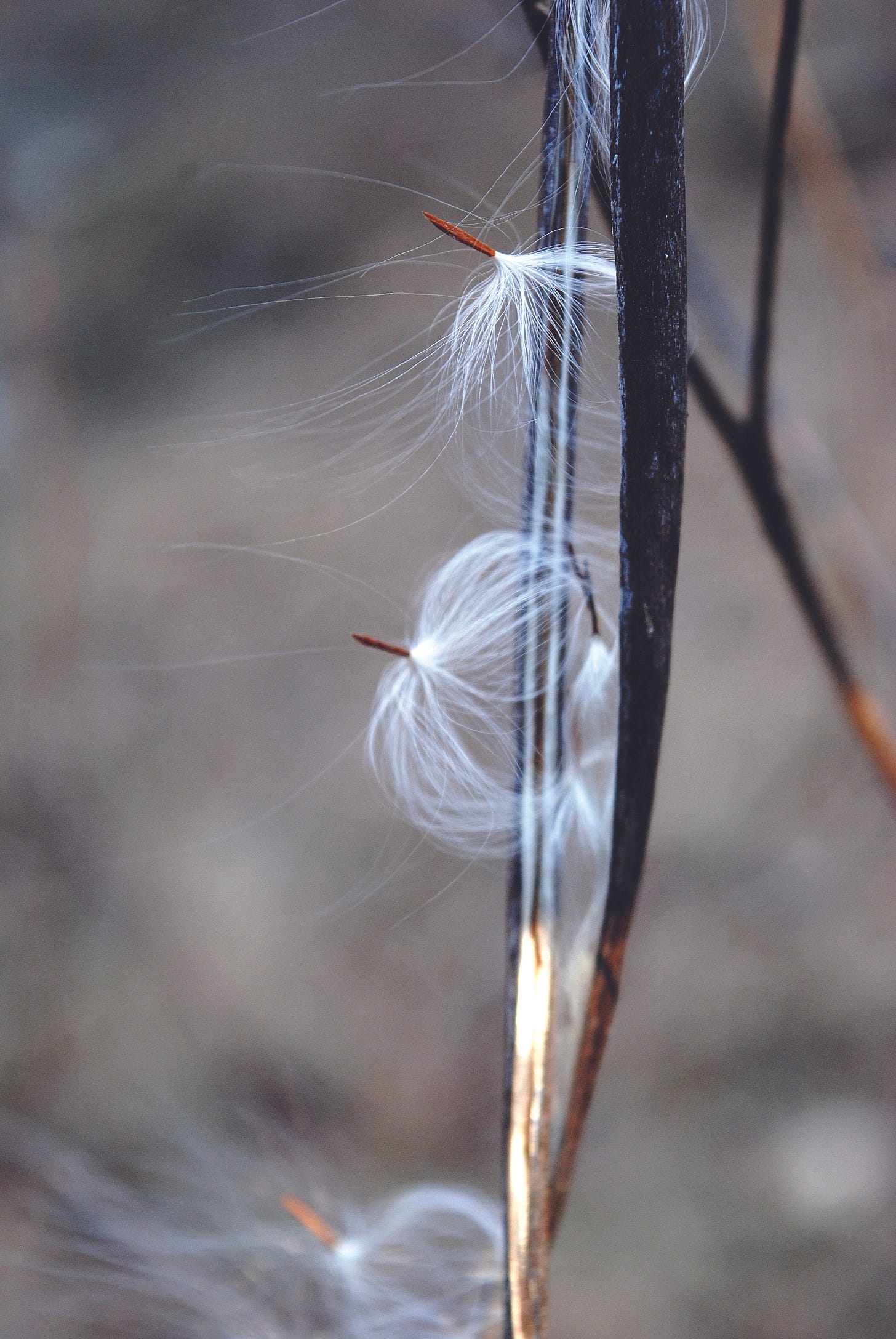
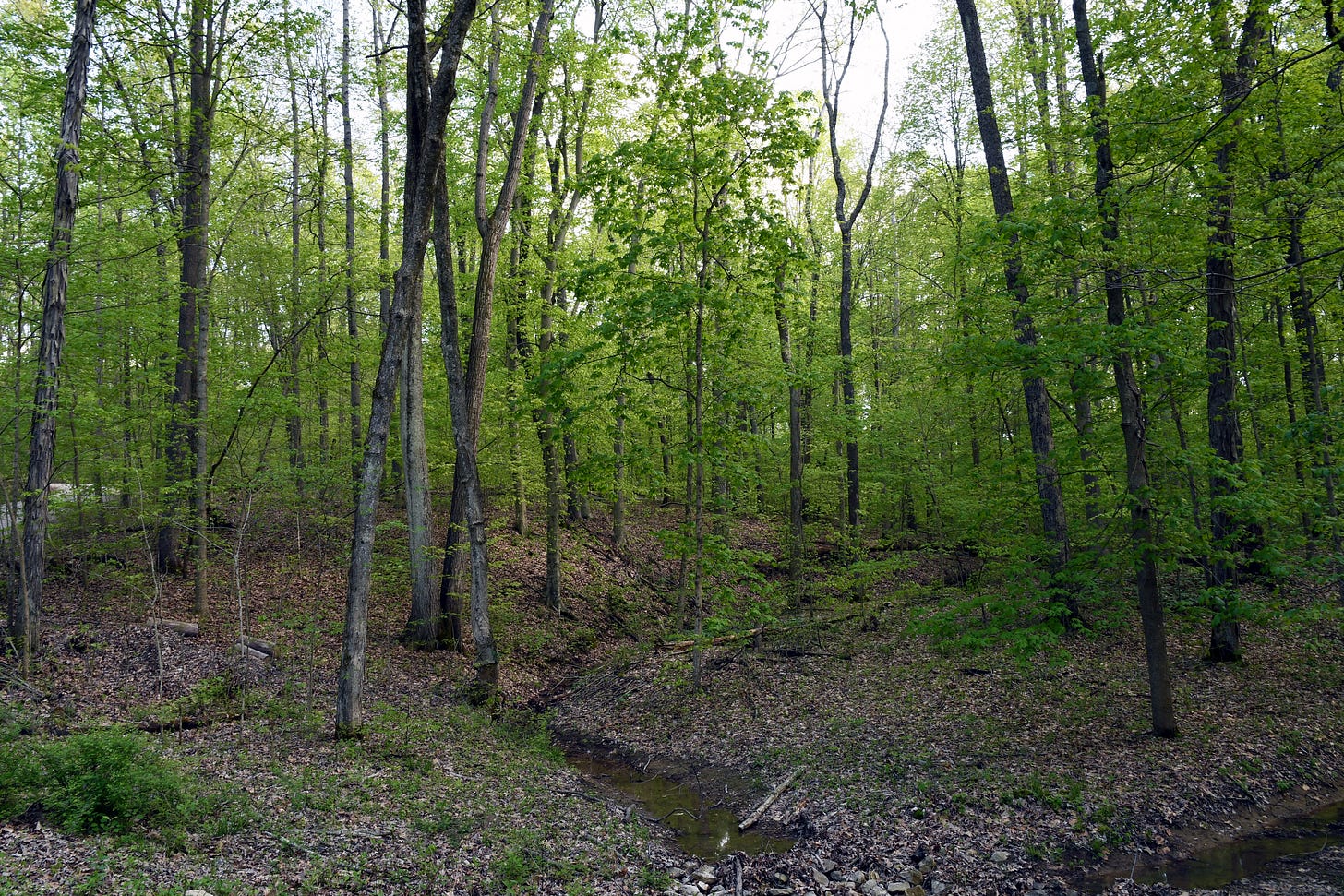
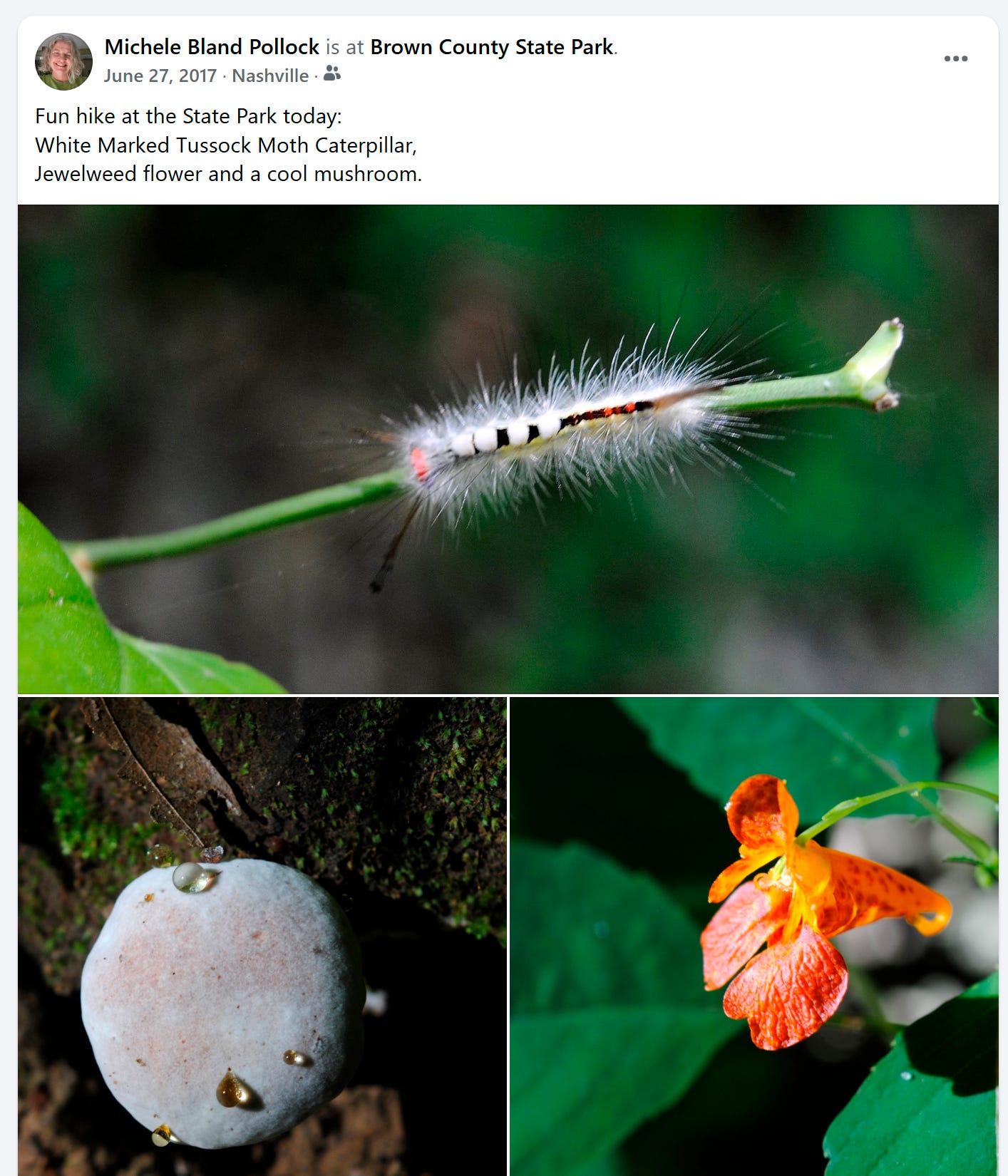
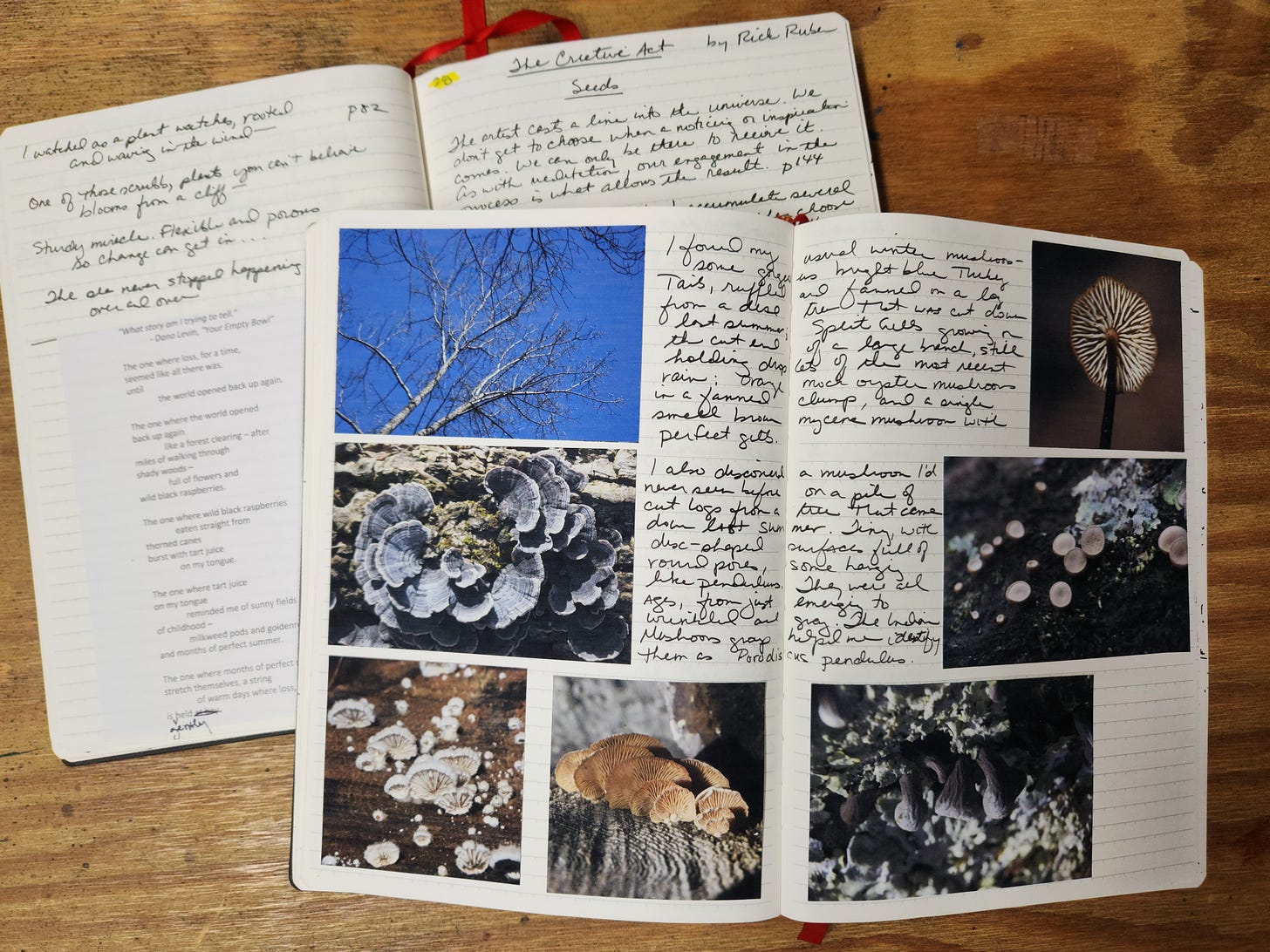
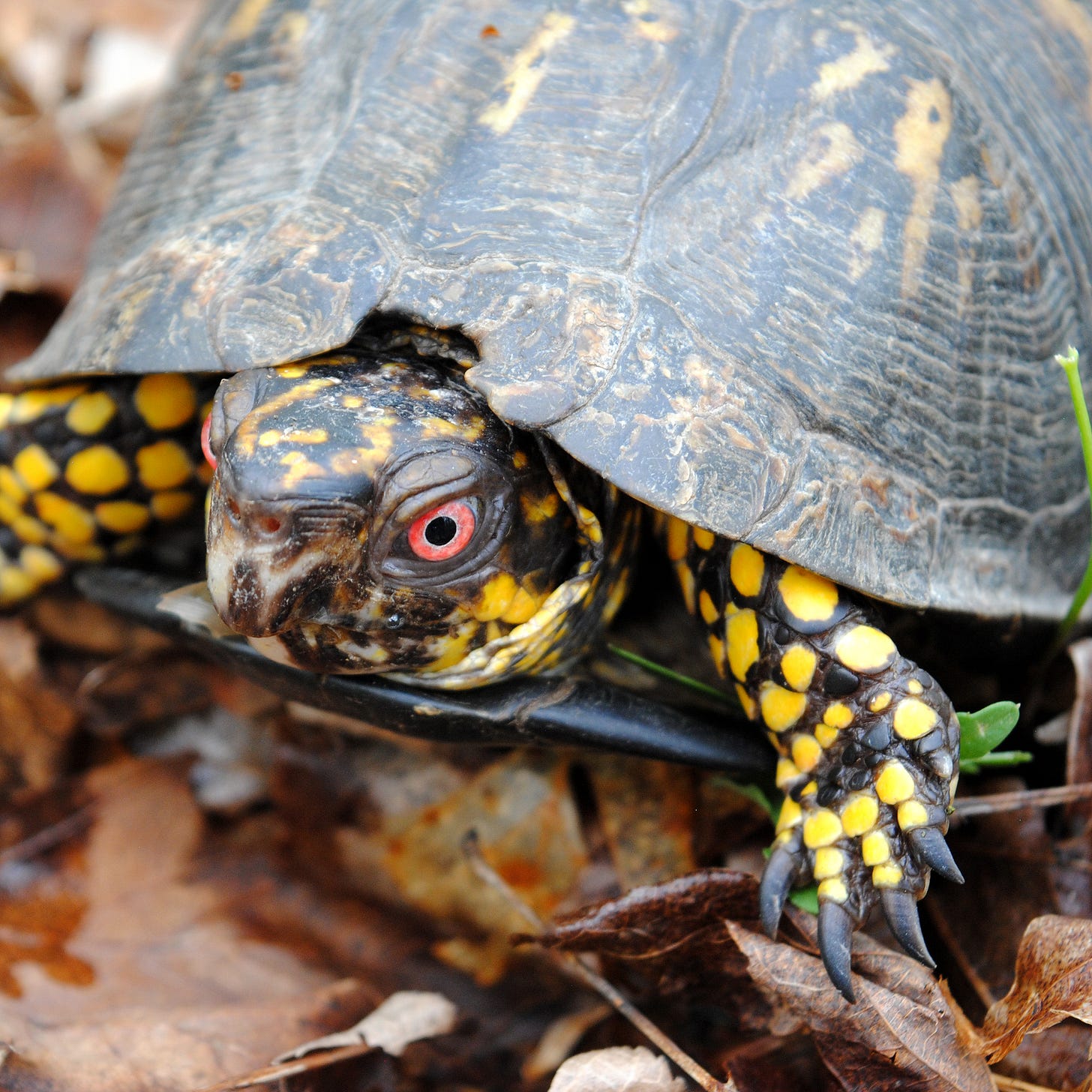
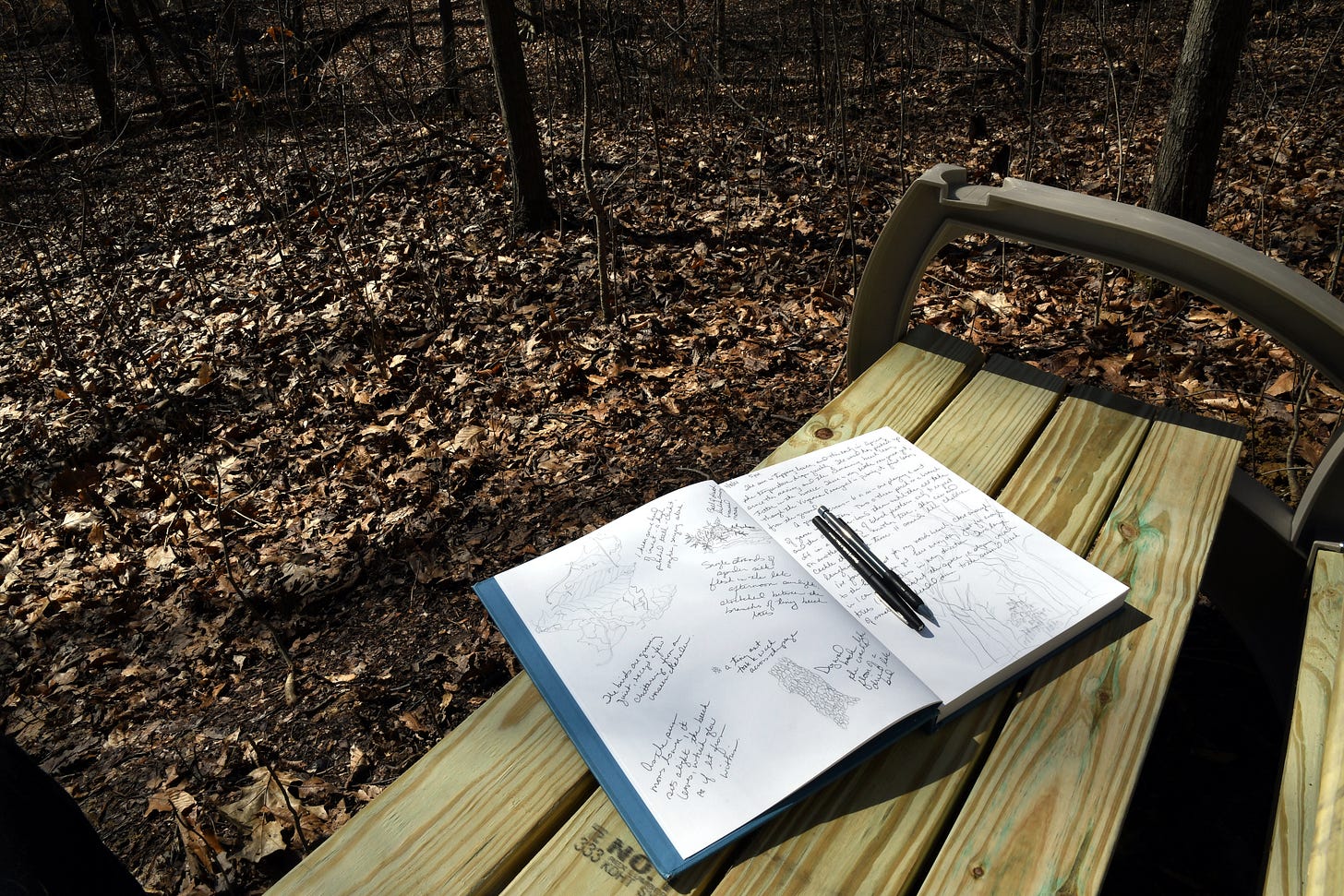
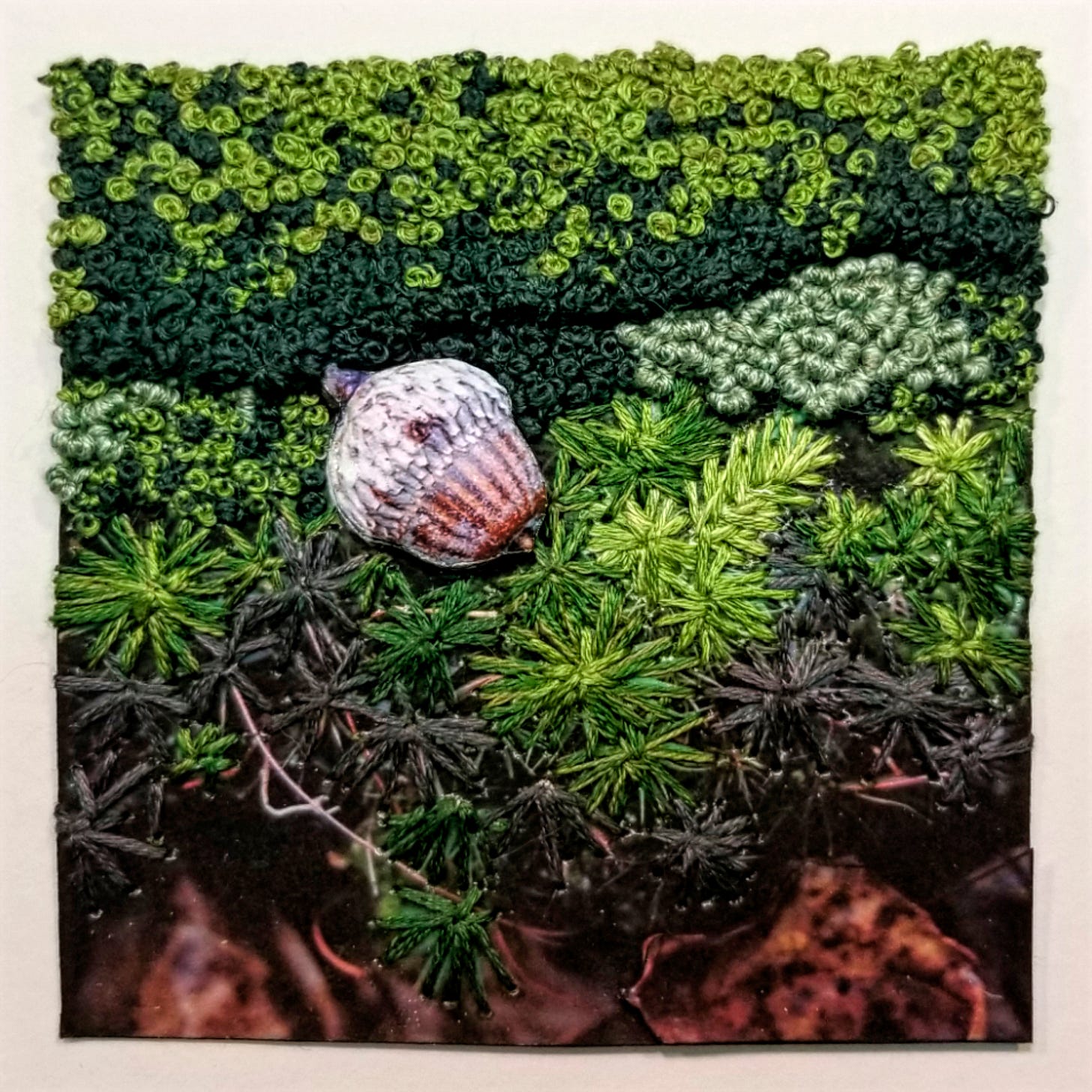
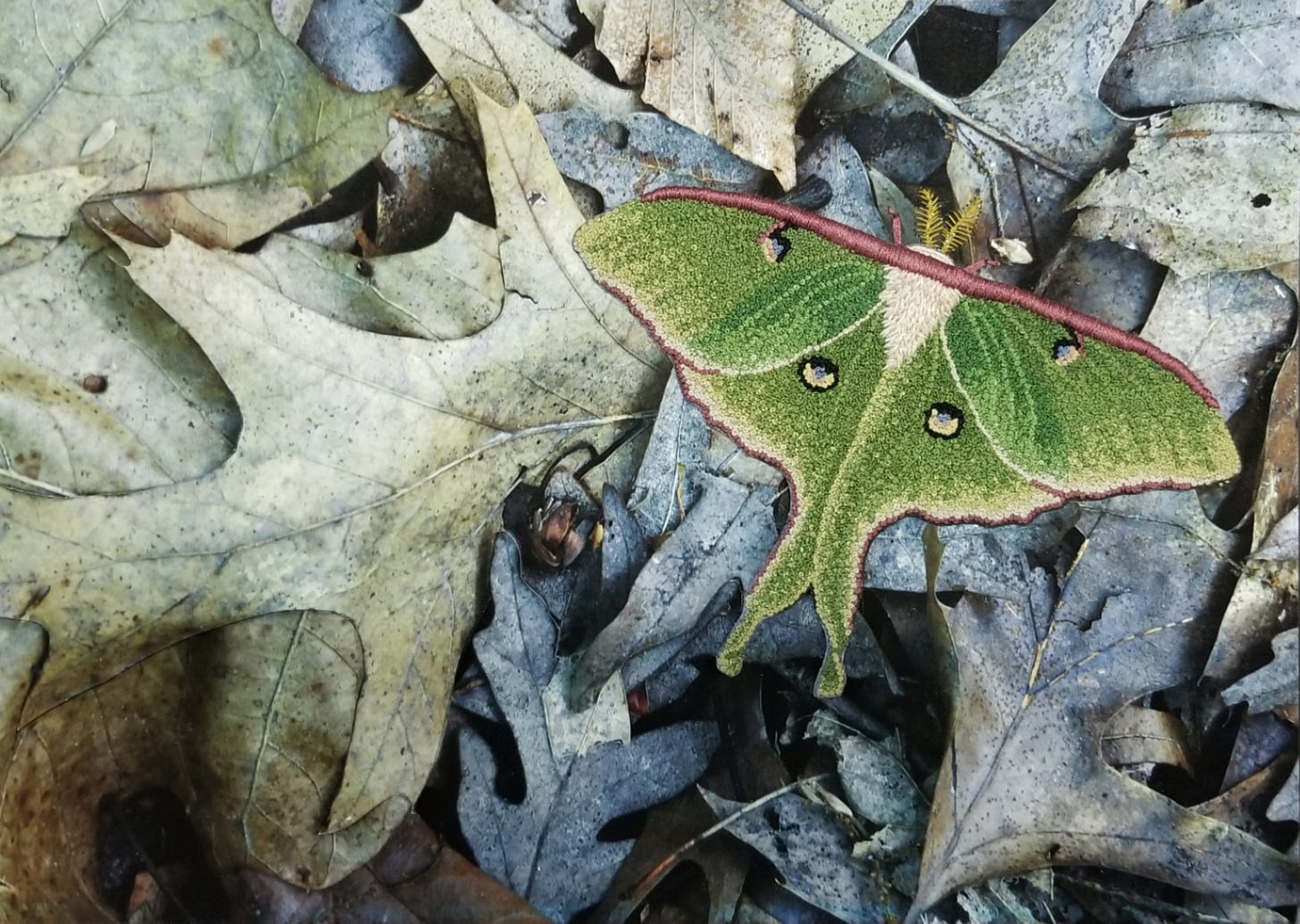
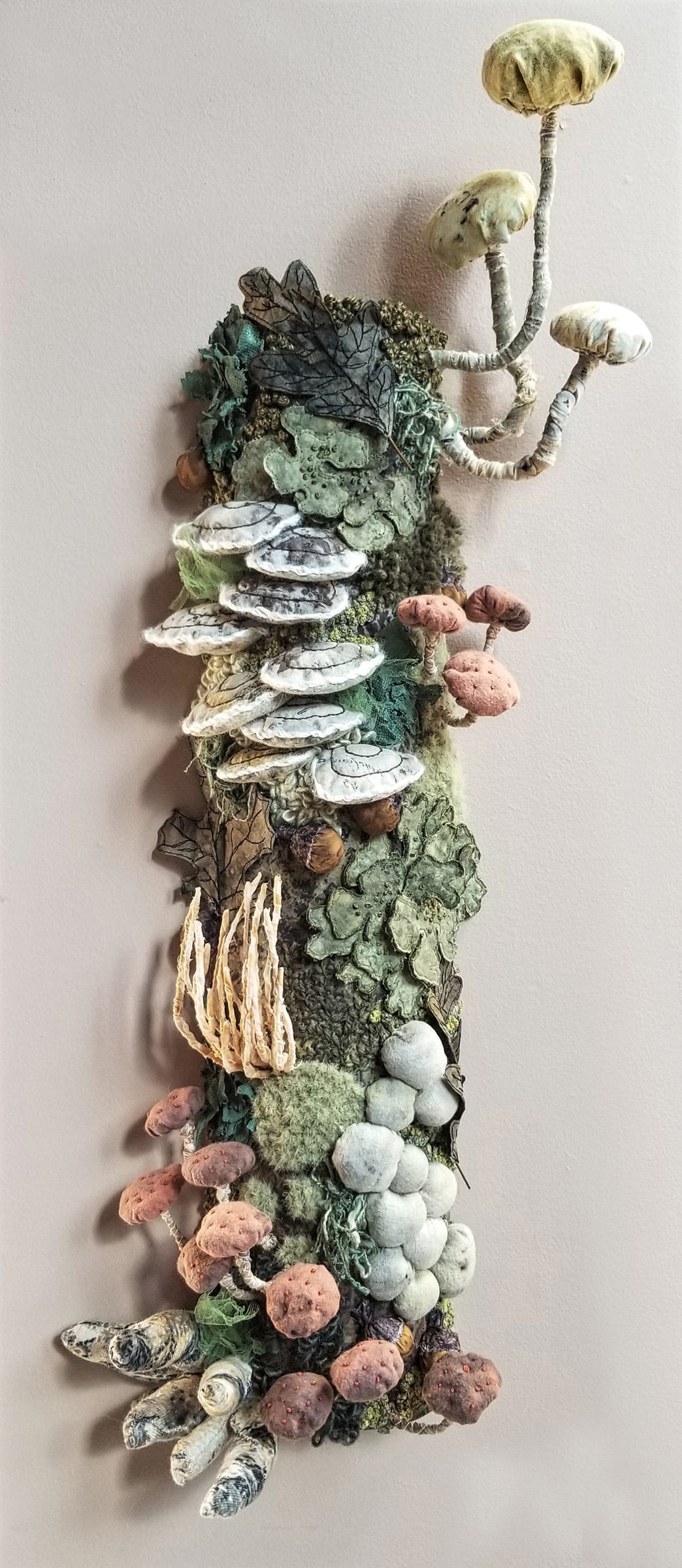
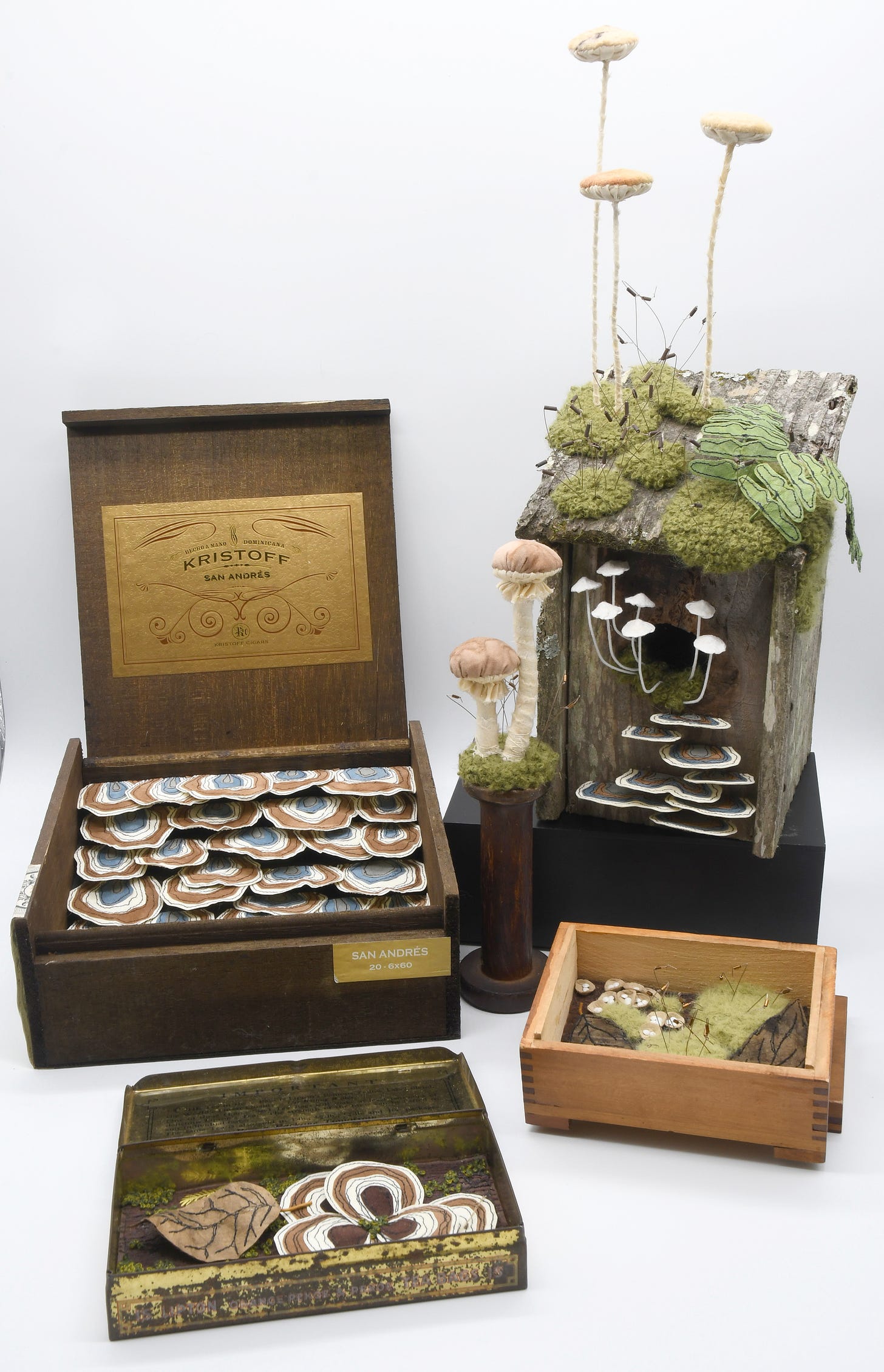

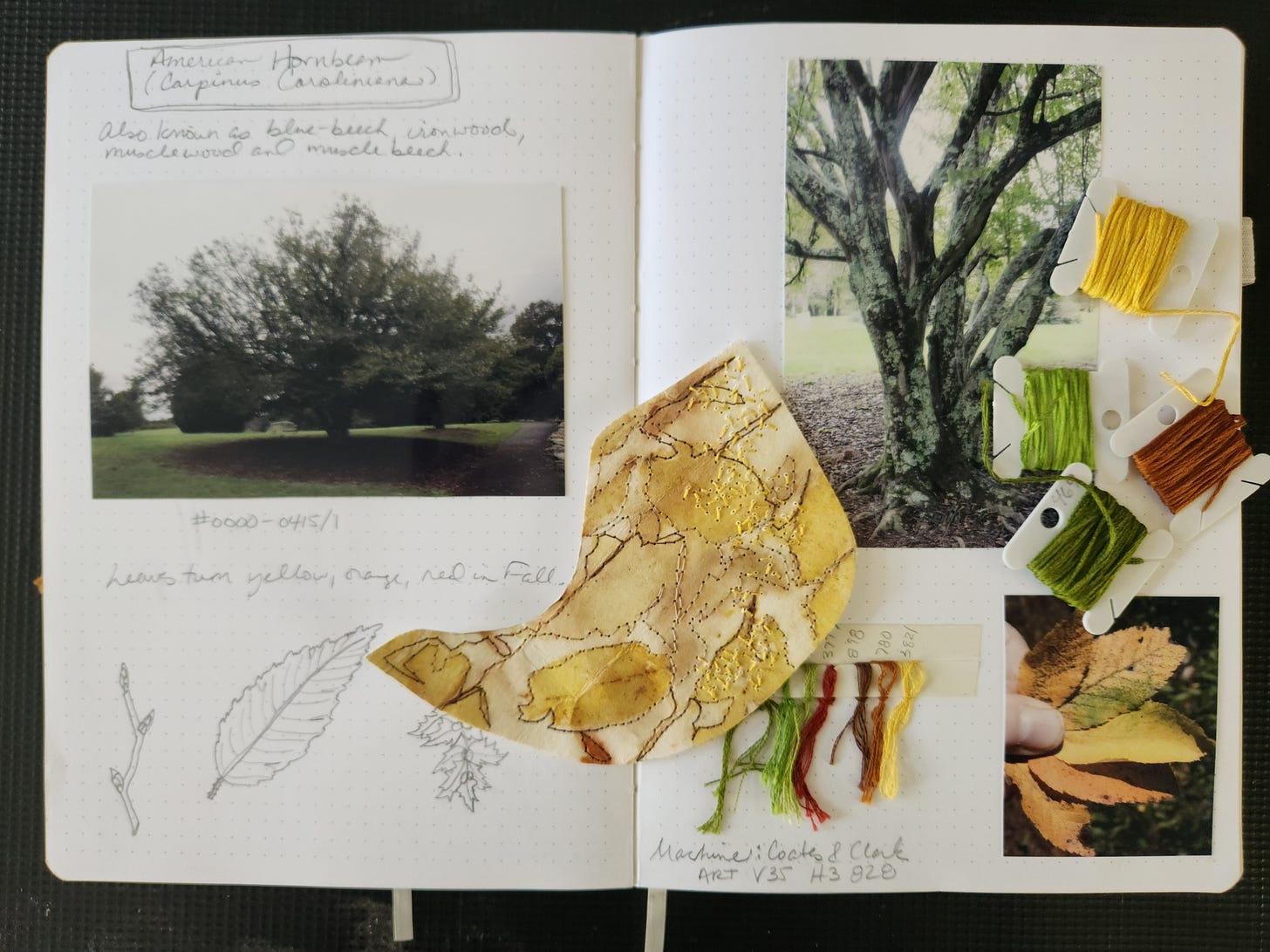

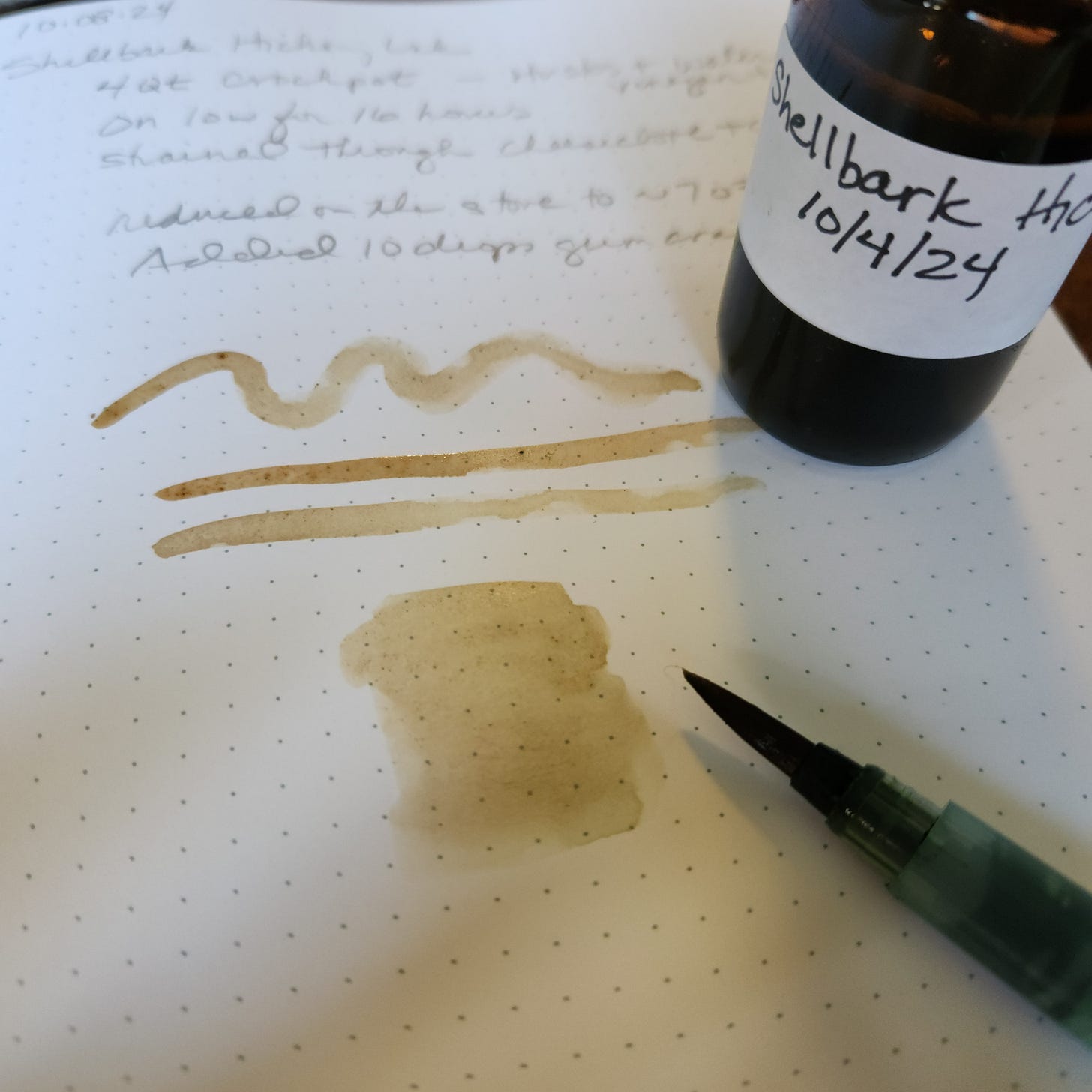
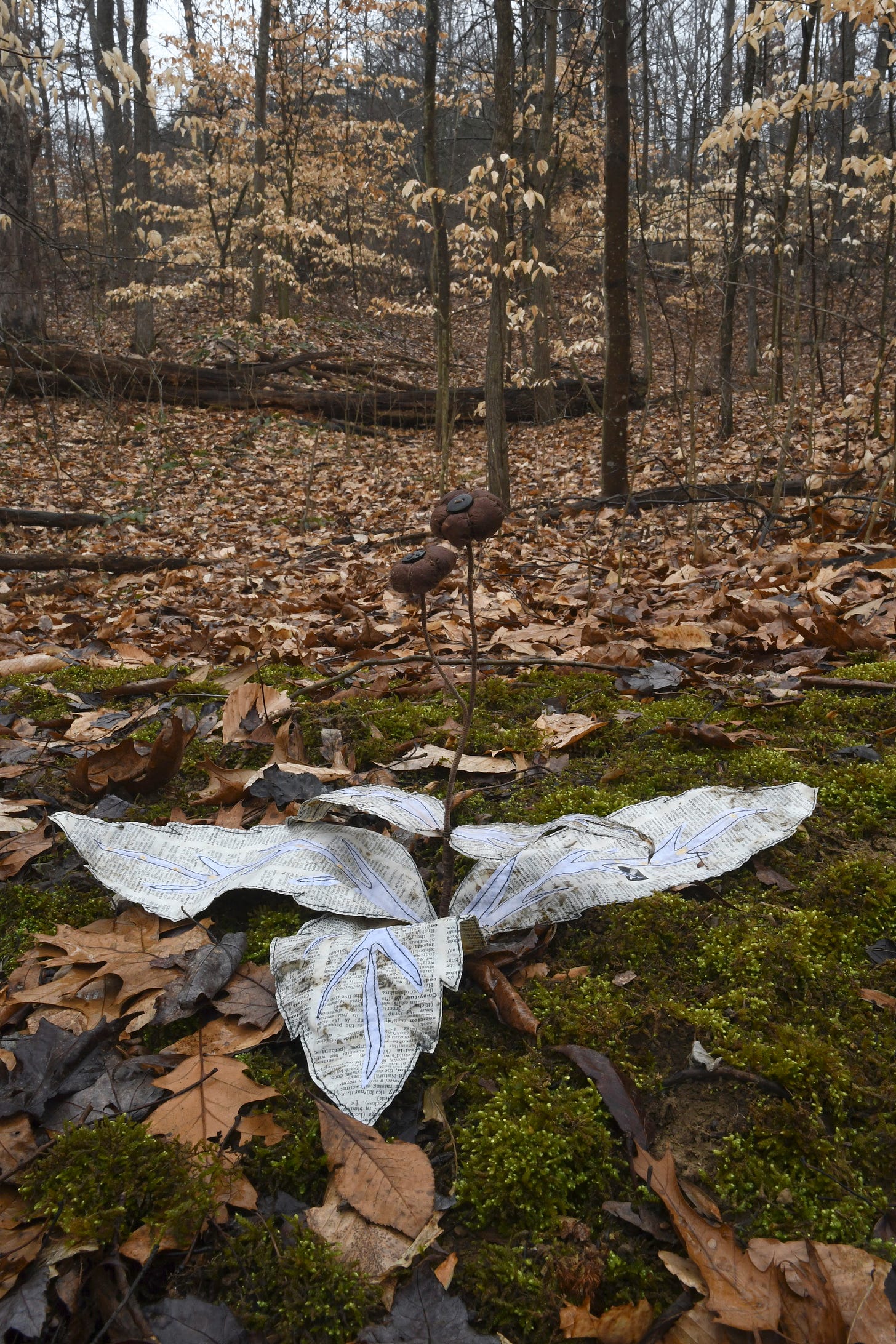
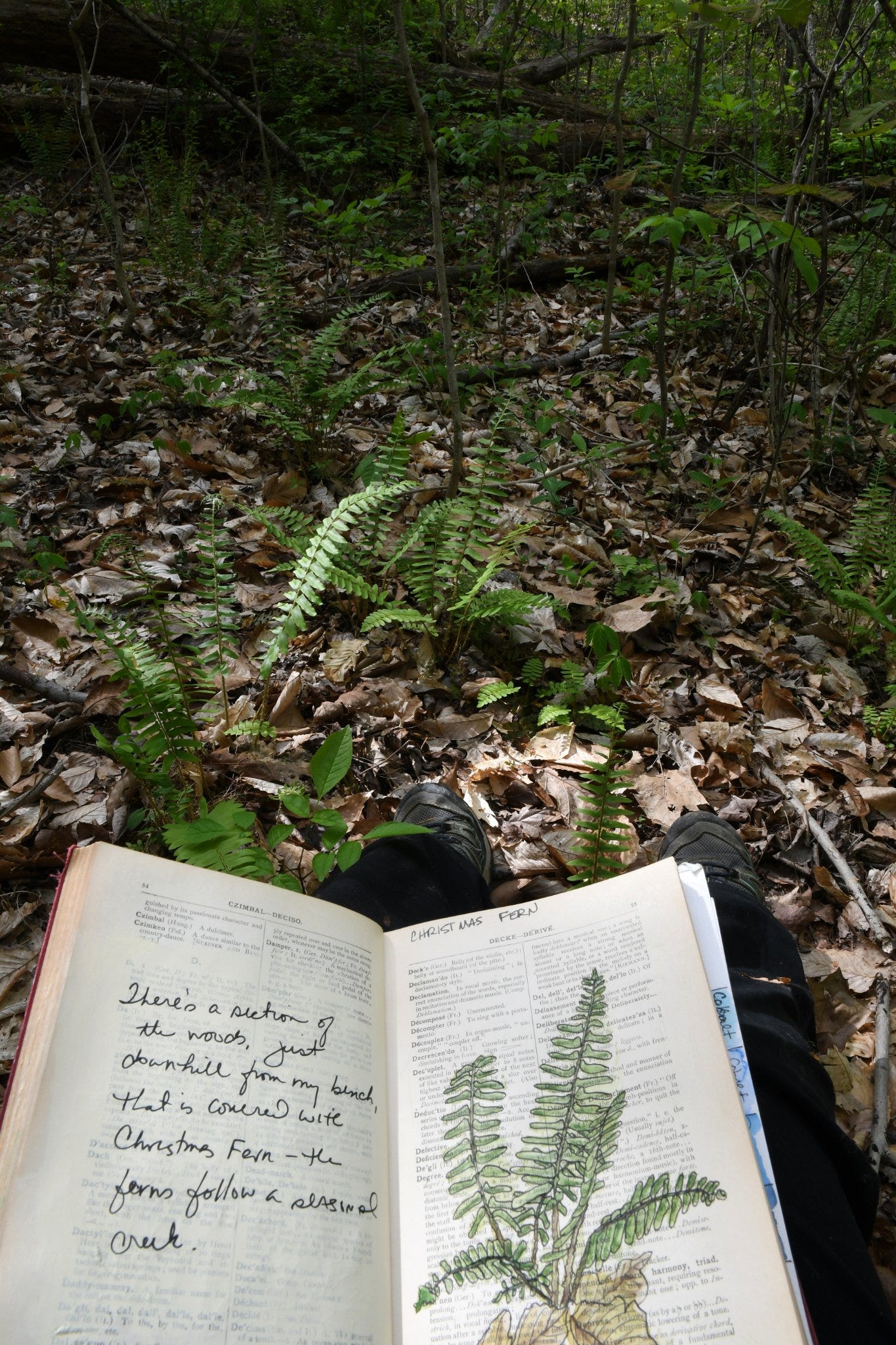
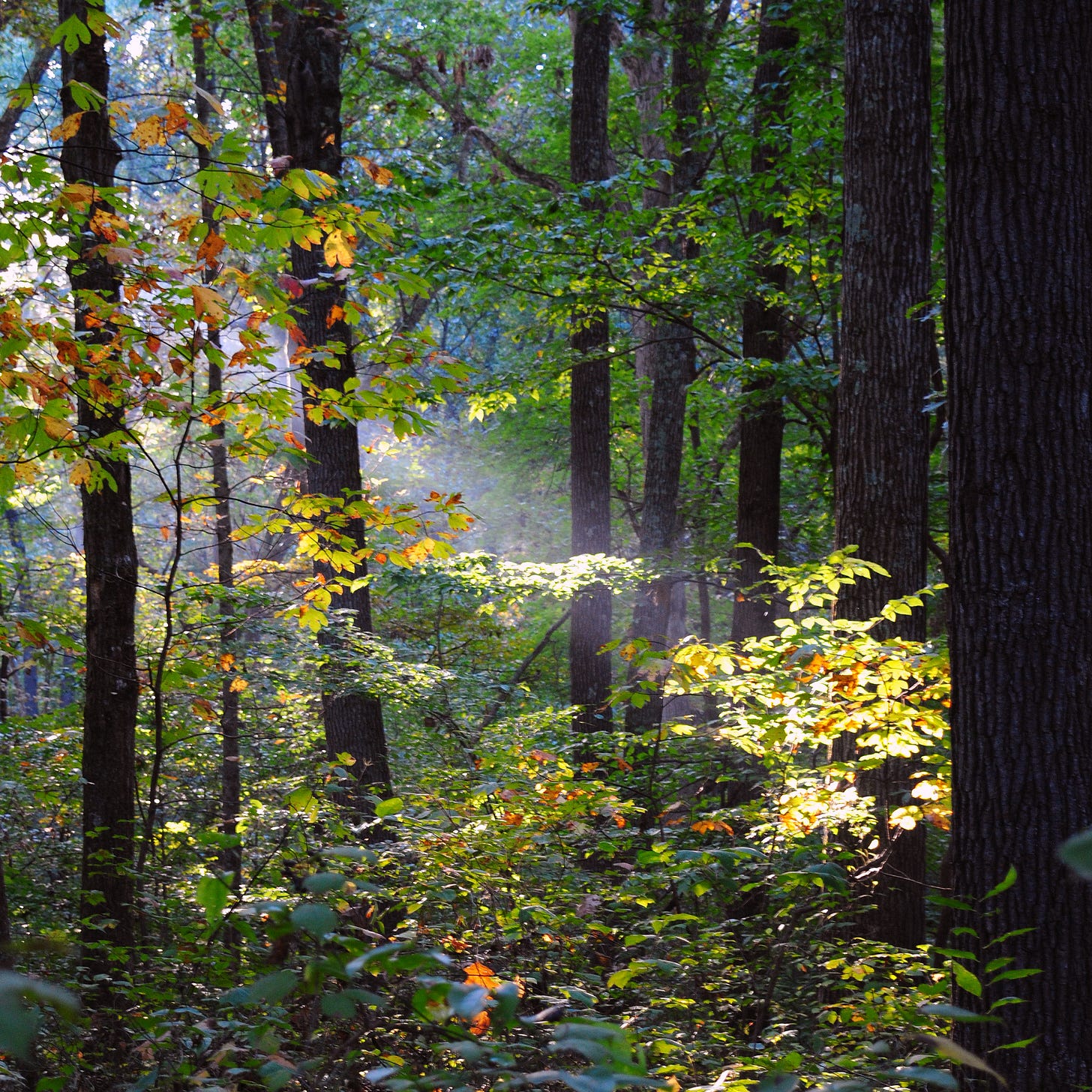
Good morning Michele! I love reading about how your art process and journey have evolved by slowing down in the woods. You give me hope and joy! Thanks!
This past winter, our neighbor cleared a trail in our woods, and now that the sun has a chance to produce growth, it’s been a delight to walk slowly and explore, mostly on the ground, because I have to look down to make sure I’m not going to trip. Hah! Over the years, walks in my woods have mostly been slow like yours, breathing in everything the earth has to offer. I’m mostly enamored with moss and fungus and mushrooms. Just the other day, I spotted a prairie Trillium just off the path and a hermit thrush, a first for both.
Your art is beautiful, and I loved reading about it how it evolved. 💚